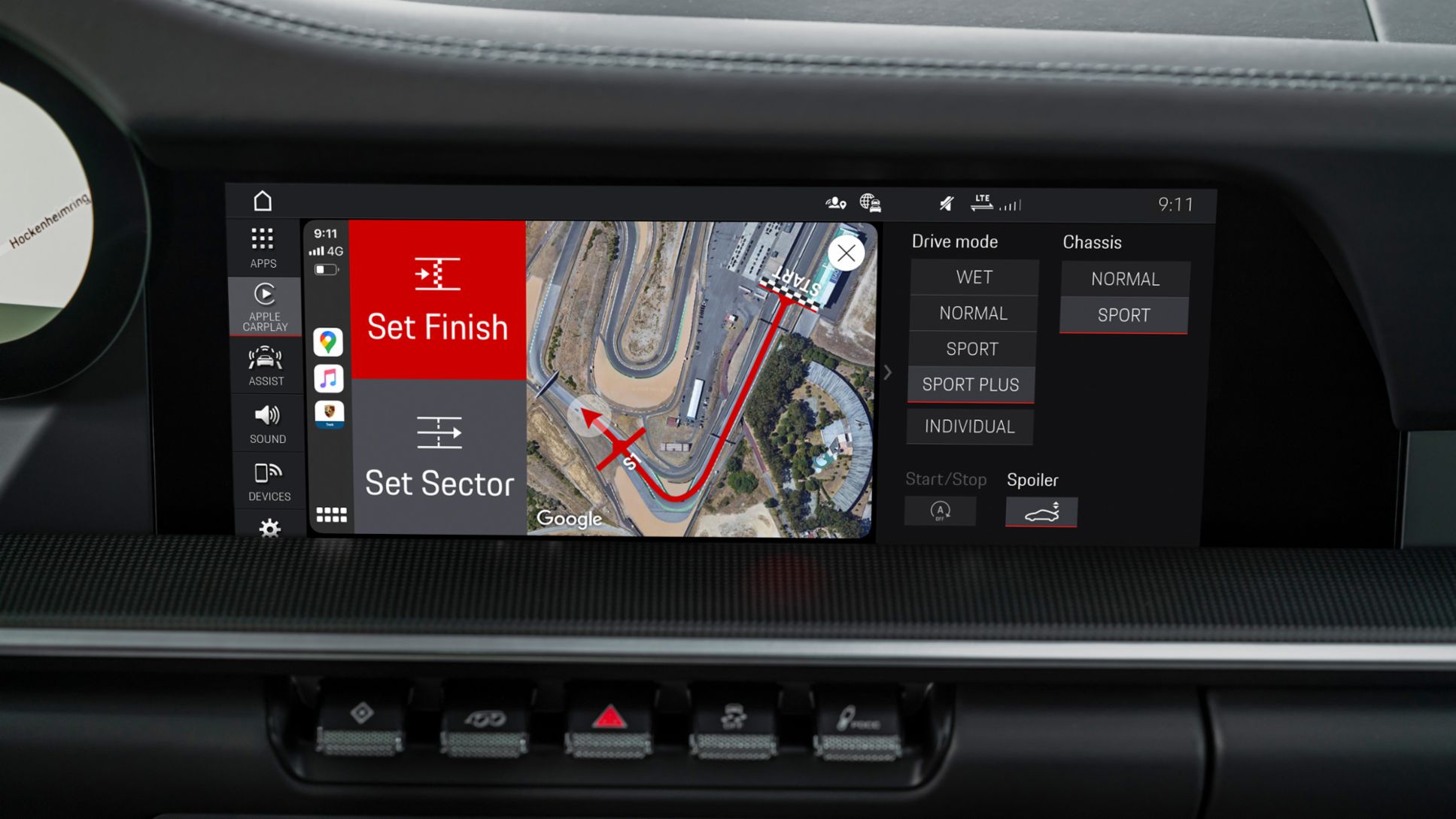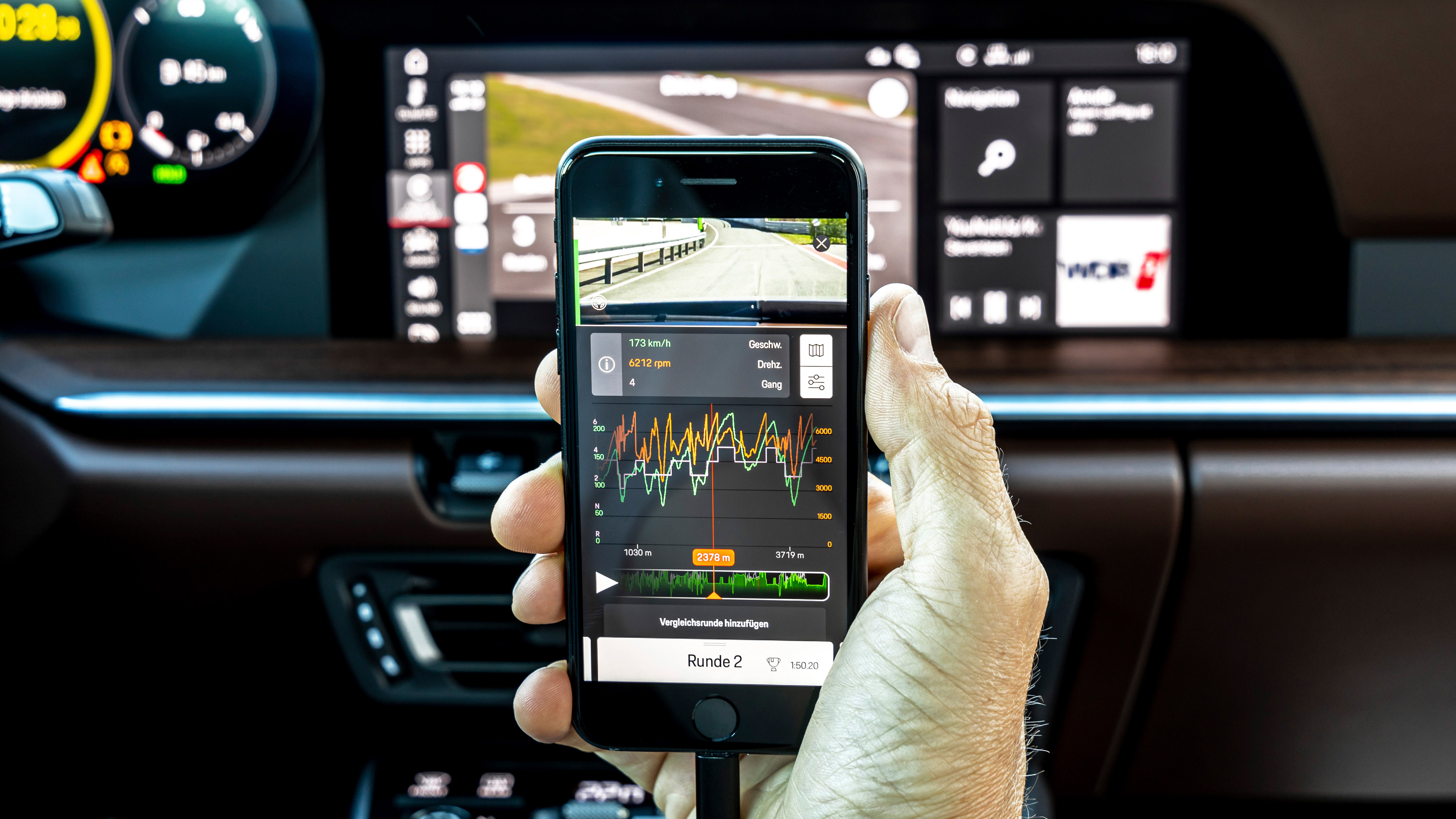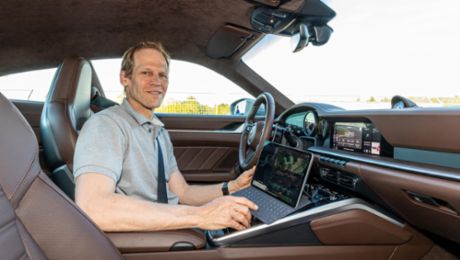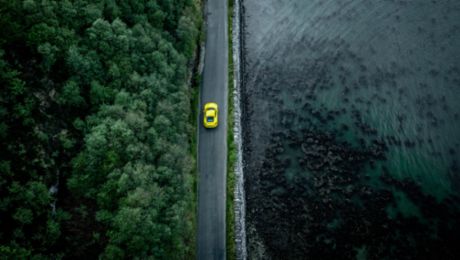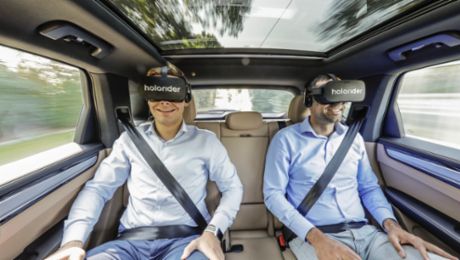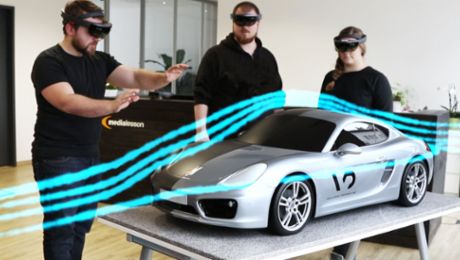The Porsche Track Precision App enables drivers to record videos, lap times and car data in one place, for detailed analysis and sharing. Keen to try it out, we joined Porsche’s Sport Auto Perfection Training 2020 at the Nürburgring Nordschleife so we could discover if, like the Porsche Offroad Precision App, it would see us approach the driving task at hand in an altogether different way.
First, a little info about how it works.
Porsche Track Precision App: tracking
The Porsche Track Precision App (PTPA) is a bit like one of the myriad of fitness apps, but for cars. It is available for iOS and Android devices and, if a Porsche has the Sport Chrono package, the app will pair with the vehicle to enable the driver to track their lap times on more than 300 racing circuits worldwide.
It’s a good idea to put your phone in a windscreen-mounted cradle and you can record video at the same time as collecting data – and if you’re unfamiliar with track driving and need a few pointers, it will offer tips, too.
While most apps or hardware solutions make use of the smartphone’s quite simple sensor data, or information obtained via the car’s OBD diagnostic port, the PTPA is unusual in that it receives its data directly from the different control units in the car. This not only gets round latency issues, but is also much more accurate. The amount of information available for later analysis is vast, and it can be viewed either as a graph or alongside the video recording.
The standard groups are:
- driving speed, engine speed, gear
- accelerator position, braking pressure, steering angle
- driving speed, lateral acceleration, longitudinal acceleration
- wheel slip
- oversteer, understeer, ESC
- tyre pressure (for each tyre)
In addition, your position is recorded by GPS, which is something many smartphone apps have problems with. In most instances, the refresh rate is around 1 Hz – in other words, your position is determined once per second. While this may be sufficient for navigation, it simply won’t cut it on the race track when you’re travelling at 200 km/h or 55 m/s.
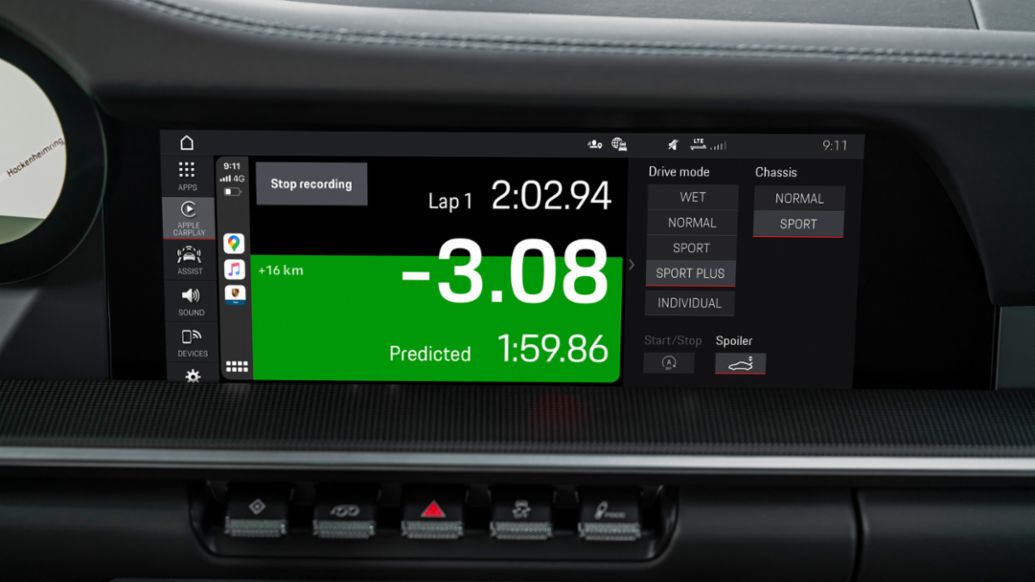
In the case of the PTPA, the GPS antenna of the Porsche is used in a special mode, which operates at 10 Hz. If you want to dial up that precision, you can connect external Bluetooth GPS antennas with 20 Hz. These times can be displayed in an extended lap timer so you can compare with your own best time, or an imported third party time.
The PTPA can also be paired, via Bluetooth, with an external camera, such as a GoPro. The recording can be started and stopped via the GoPro and the results can be integrated into the app later with synchronised timing. And if that’s not enough, it is also possible to synchronise your pulse via Apple Watch, with the data you gather then being available for evaluation on a smartphone or tablet.
During the two days I spent exploring the app at the Nürburgring, I had plenty of time to discuss its features with Eduard Schulz – the technical head of the department for Connected Car Drive apps at Porsche.
For those who aren’t so lucky, the app – which is available free from the AppStore – comes with a guide that includes a film recorded by Walter Röhrl in a GT4.
Sport Auto Perfection Training day one: the absolute beginner
There is a good reason that the Nürburgring Nordschleife is known as the “Green Hell”: not only is it the longest circuit in the world, but it is also considered one of the most dangerous. While I was delighted to be invited there by Porsche, I travelled with some trepidation, having only ever completed three “tourist” laps many years ago. My hopes rested on my general driving experience and the instructor who would accompany me around the track.
The programme started at 08:30. We drove to the Döttinger Höhe straight via the normal access but turned left towards Gantry. A total of 26 groups assembled for a briefing from our instructor, Timo Kluck.
The night before, other members of our group – made up of four journalists – had been full of praise for Kluck. Among his many nicknames is the “tyre whisperer”, because he is normally responsible for tyre and wheel development at Porsche.
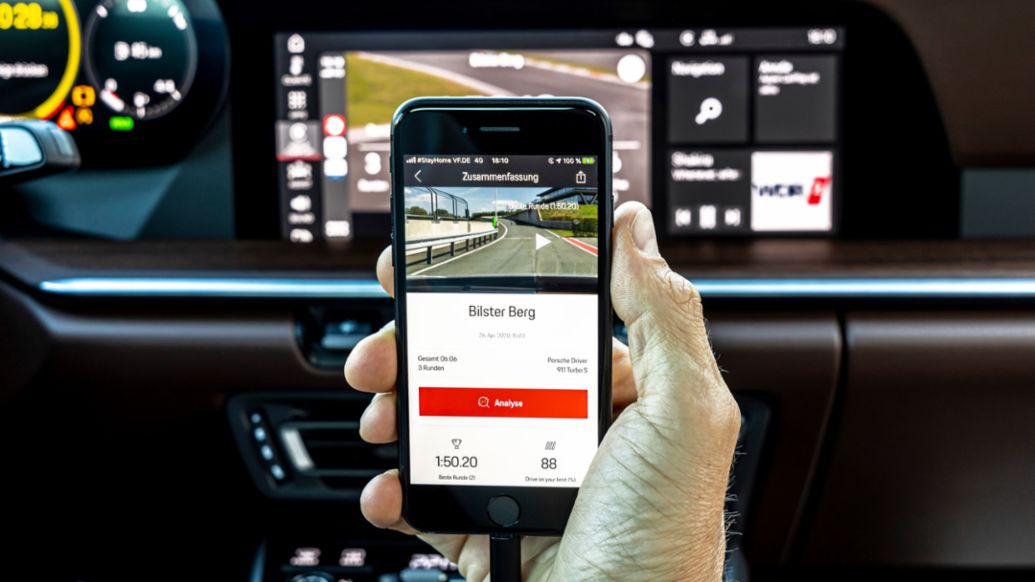
After the briefing, it was straight to the car and onto the track. The first laps on day one were aimed at getting us familiar with the circuit, but the speed increased with every lap nonetheless.
While the Porsche Track Precision App was running from the start, all attention in the morning was focused on learning the course – and it felt like a very steep learning curve.
After lunch we returned to the asphalt, and this time I used the Porsche Track Precision App to record a few laps, ready to study them in more detail that evening with Schulz.
I watched as the Bridge-to-Gantry times shrank from 8.45 minutes in the morning to around 8.15 minutes by the afternoon. My personal best lap time came in at 8.04 minutes and I soon had my heart set on reducing that to below the eight minute mark.
Over dinner that night we had a quick look at the data on a smartphone, and Schulz shared some pointers – particularly in relation to braking – so that I could look at improving my times the next day.
Sport Auto Perfection Training day two: putting theory into practice
After a night of typically thunderous Eifel weather, the following morning greeted us with sunshine although when we assembled on track at 08:00, some wet patches remained.
We began with some practice laps, quickly picking up speed and focusing on clean techniques – one eye on the data the Porsche Track Precision App was collecting.
At midday, we were split into two groups and a free driving session was announced: the Döttinger Höhe straight was cleared for use and permission was granted to start overtaking manoeuvres.
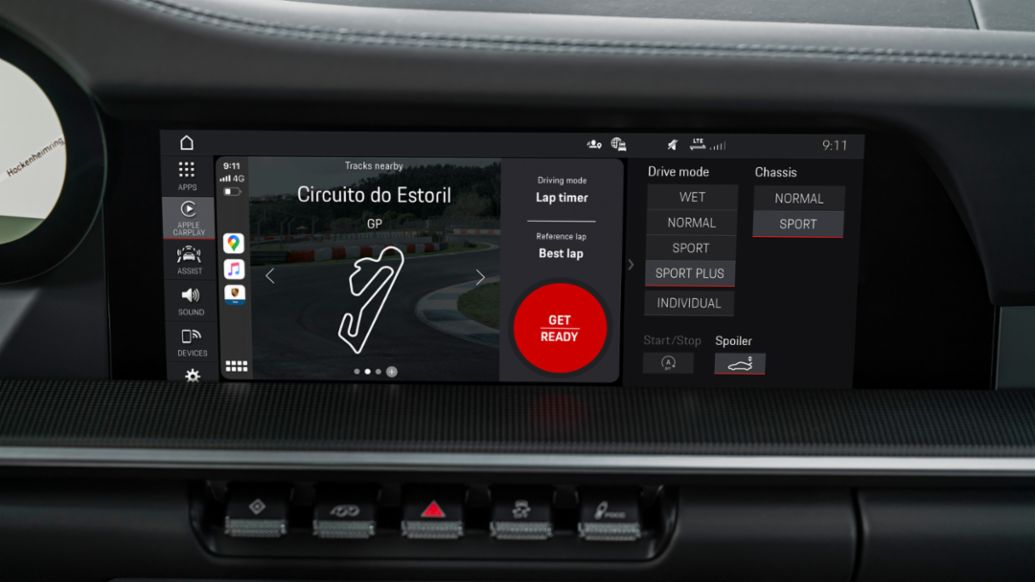
Porsche Track Precision App: analysis mode
While the other group was on the track, I used the time to take a detailed look at the data we’d gathered the previous day with Schulz, having exported the information via Airdrop to his tablet (checkout the video accompanying this article to see some of the analysis).
When looking at the data in graph-form, we paid particular attention to a diagram showing accelerator position, braking pressure and steering angle. It was clear to see the places in which I hadn’t braked cleanly or where I had perhaps taken my foot off the accelerator too soon.
“The map view, which shows your position on the track in parallel to the video, offers a fascinating insight.” Mark Kreuzer
The map view, which shows your position on the track in parallel to the video, offers a fascinating insight. Here, for example, I could view acceleration forces, which showed the corners in which I perhaps wasn’t driving smoothly enough, or those where I could have ventured a little closer to the limit – that crucial point where getting nearer usually means more pace, but which you also do not want to exceed.
There is a “Drive on your Limit” value in the PTPA, which is specified in percentage terms. The idea behind this is rather charming: the value serves as a reference for how close you get to your personal limit. It would make little sense for me to compare my lap times with the records set on the Nordschleife – I would always be slower than a professional racing driver – but it is always possible that traffic around you on the track has prevented you from achieving your best time. The “Drive on your Limit” value therefore predicts your performance based on acceleration, meaning you can get a good idea of how you are driving within the range of your capabilities.
This information also removes some of that pressure to concentrate only on your lap time, which does not take into account factors such as weather or tyre condition. Interestingly, in my case, this value closely matched my personal estimation.
Analysis of my data complete, it was time to leave Schulz and head back on to the track to put theory into practice.
The Nordschleife in a Porsche 911 Carrera 4S
At this point I should perhaps mention the car I was driving on the Nordschleife: a current generation 911 Carrera 4S.
At the end of the second day I would have perhaps liked an individual session with Kluck, but since the last two laps of the day were both sub-eight minutes, I had achieved my personal goal and left the track more than happy.
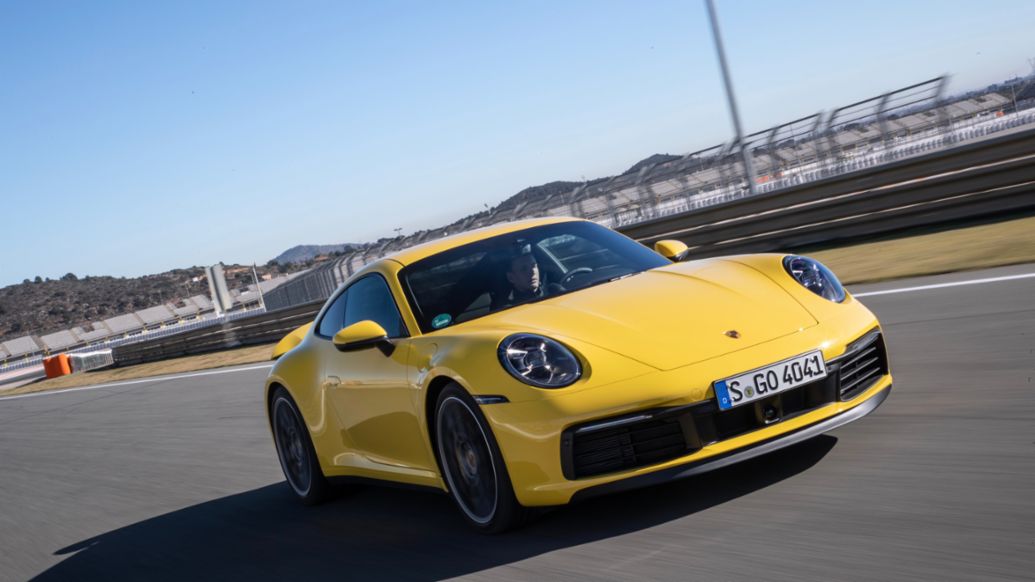
Ultimately, it is not possible to say whether the 15 seconds I shaved from my time came from the PTPA analysis. However, I definitely found the visualisation helpful: the combination of accelerator, brake and video in particular showed me where I had made general symptomatic mistakes.
Professionals will, without doubt, be able to use the app to drill down to specific corners where errors were made or to see where there is potential for improvement.
“I think that the PTPA is without doubt a very exciting tool for different coaching situations.” Mark Kreuzer
For me as a beginner, it was exciting to be able to analyse different driving situations in more detail. I think that the PTPA is without doubt a very exciting tool for different coaching situations: the instructor can transfer a target reference time to participants’ devices by Airdrop or download, for them to then use as a reference lap for the extended lap timer.
The extended lap timer is very useful – particularly with the latest update, which supports CarPlay. The running time is displayed on the main screen for easy reading and in normal mode it takes the different sections of your various laps and compares them with those of your best lap.
In doing so, this again relieves a little of the pressure on a driver. It goes without saying that not every section you drive will be your best, but if all the other sectors on the display are illuminated green then you know that you are driving a good lap. This eliminates the tendency to fixate only on lap times.
Summary
When I reviewed the Porsche Offroad App, I said at the time that I wouldn’t have thought to take a Porsche offroad until I heard about the app. While the thought of driving a 911 or another Porsche on a race track is perhaps more obvious, it is also slightly more daunting and I experienced for myself how a “normal” 911 has motorsport DNA.
The PTPA provides plenty of information about how to drive on a race track and about the things you have to pay attention to with a car. As I mentioned at the beginning, I had already completed three tourist laps before I was invited to the Nordschleife with Porsche, but knowing what I know today I think it makes more sense to take part in a track day first, with an instructor on hand. I would then let the app run while driving; it is really interesting to see how your skills develop and improve.
Since my experience, I have thought about going to the ‘Ring more often, but the question of how to finance this still remains. Unfortunately, this is something with which the app can’t help …
Info
Text: Mark Kreuzer for Mobile Geeks
